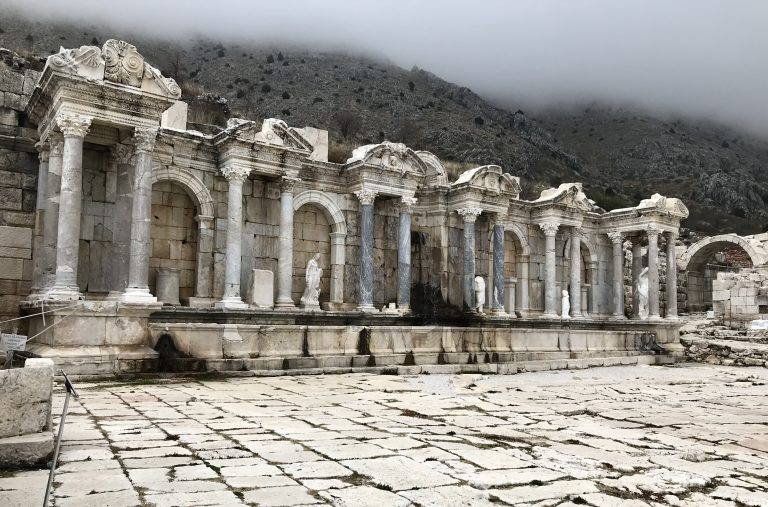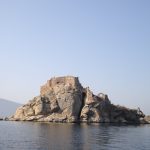For visitors who relish the dim and distant past there are few places better to explore than Turkey. The country is thickly dotted with archaeological sites, many of them well known and enthusiastically visited, others familiar only to the select few. Which are the finest of them? That’s a tough call, and the following is but a tentative list, based more on the quantity of ruins and the beauty of their setting than on their historic significance.
Ephesus (Efes)
No list of Turkey’s archaeological treasures could begin anywhere other than at Ephesus, the sprawling site just east of Selçuk that was at one time the capital of the Roman province of Asia Minor, with a population of around 250,000 people. Nowhere else in Turkey (or in Greece, for that matter) can you get a better sense of what it might have been like to live some 1800 years ago; as at Herculanium in Italy, it’s even possible to go upstairs inside some of the frescoed Terraced Houses (Yamaç Evleri), and you can hardly get much more atmospheric than that. Highlights of Ephesus? Too many to mention, but pride of place should surely go to the iconic Library of Celsus, the theatre with seating for 25,000 people, the titter-inducing communal latrines and the battered agora, or marketplace.
Aphrodisias (Afrodisias)
If Ephesus has one problem it’s that it’s a bit too popular for its own good. The same is not the case with almost equally impressive Aphrodisias because its inland location west of Denizli makes its less convenient as a destination for day-trippers and cruise parties from the coast. Here you can wander in peace and quiet amid the extensive ruins of a city that was once capital of the Roman province of Caria. The population of Aphrodisias probably never topped 15,000. However, it was well known for a particularly popular shrine to Aphrodite, the Greek goddess of love, hence its name. Highlights? The ruined stadium is especially spectacular in spring when it fills up with poppies but the museum also contains a wealth of statuery of the type for which the city was also renowned. Its museum is one of the finest on-site museums in the country, showcasing the splendid sculptures that once graced the Sebasteion temple here.
Hierapolis
Most people come to Pamukkale with the famous snowy-white travertine formations cascading down the hillside foremost in their thoughts. Some are disappointed that it’s no longer possible to swim in the pools. But those who set their sights on exploring the ruins of Hierapolis immediately above the travertines usually come away much more satisfied since this was another of the more stupendous cities of the Roman era. Here you can still swim amid columns fallen from a Roman-era edifice as well as peer (cautiously) in on a poisonous spring called the Plutonium. The sprawling necropolis is especially worthy of a visit, as are the vast agora, Frontinus St with much of its original paving intact, the restored theatre and a curious structure seemingly built over the site of St Philip’s martyrdom in c.80 AD.
Pergamum (Bergama)
The ruins of ancient Pergamum, a city once famous for its medical facilities and for having given parchment to the world, lie at opposite ends of the modern city of Bergama, north of İzmir. The remains of the Acropolis stand proud to the north, the single most staggering monument being the theatre which is cut into the hillside at an angle that would have induced vertigo in some of its 10,000-capacity audience. It’s a long walk south to the remains of the Asclepion where the great physician Galen (131-210) used to work. On the way you might also want to look in on the massive but gloomy Kızıl Avlu (Red Basilica), once a temple to a trio of Egyptian deities and then a Byzantine church.
Priene, Miletus and Didyma
South of Kuşadası, these three wonderful archaeological sites can easily be visited in the same day by private transport. Each has something special to offer: Priene has its magnificent hillside location with spectacular views out over the floodplain of the Meander river; Miletus has a huge theatre in an extraordinary state of preservation; and Didyma boasts the ruins of a temple dedicated to Apollo that was once the second largest in the world, outstripped in the size stakes only by the Temple of Artemis, Apollo`s sister, at nearby Selçuk. Miletus has the plus of an abandoned mosque, the İlyas Bey Cami, dating back to 1404 just down the road from the ruins. Without private transport to reach the sites you may find yourself seeing more of Söke bus station than you might have wished.
Patara
Visitors to Patara are often so keen to spread themselves out on the 20-kilometre swathe of sandy beach that they fail to notice the wonders of the vast archaeological site that stretches back from it, at times getting quite literally lost in the sand dunes. Patara is wonderfully romantic, especially at sunset when the eucalyptus trees give it an eerie echo of Australia. Highlights? The theatre, as ever, but also the scatter of Lycian sarcophagi in the fields and a temple of Athena still almost lost in the scrub. Oh, and an ancient granary overlooking a small lake too.
Arykanda
While most of the sites already mentioned receive more than their fair share of visitors especially in high summer, lovely Arykanda is on the road to nowhere (well, Elmalı anyway) and so goes virtually ignored. This is a great shame since the views from its lofty theatre are almost matchless. Here, too, you`ll find a vast bathhouse, a basilica and a wonderful terrace that may have served as an outdoor council chamber with a small odeon tucked away behind it. Right above the theatre there’s even a stadium with seats along one side only so that spectators could soak up the view in between events. While you’re driving back down to the coast at Finike you may also want to pause at Limyra where the ruins of a temple bestride a marble plinth above the waters of a mountain spring. It’s an unexpectedly bucolic setting, the perfect counterpoint to rocky Arykanda.
Olympos
Location, location, location. The ruins of Olympos are far from being the most dramatic in Turkey but they do sit immediately behind a lovely curve of beach all but lost in a dense Mediterranean undergrowth of olives, vines, oleanders and laurel. It’s a rare chance to imagine yourself an explorer – then afterwards you can climb up the mountainside to examine the Chimaera, a curious, un-extinguishable flame that ancient mariners record having seen when they were far out at sea.
Termessos
North of Antalya, Termessos is one of Turkey’s dreamiest archaeological sites, its crowning glory a theatre that seems to sit quite literally on top of the world. It was home to the Psidians, reputedly such a fiery bunch of warriors that even Alexander the Great decided to leave them alone. The theatre aside, you will also find the impressive remains of a gymnasium, bathhouse, odeon and necropolis. Bring sturdy shoes – you`ll need to do some scrambling to see everything here.
Sagalassos
Like Arykanda, Sagalassos, near Ağlasun in the Lake District, is out on a limb as regards the tour parties which makes it an excellent place for those who prefer to have their sites to themselves. Like Termessos, it was a Psidian stronghold, built once again on the slopes of a steep hill where the ruins run along the contours of the land. Here, however, Alexander the Great was able to do his worst and grab the city for himself. Purists may resent the rebuilding of archaeological monuments but it’s worth taking a look at the fountain above the library which has been returned to its original use, and at the Heroon, once decorated with jaunty carvings of dancing girls, a few of them still intact.


